Introduction
Hi readers, here we go again. With Worlds in the book, it is time for us to turn our gaze towards the brand new set: Kaladesh. If you are like me, you probably followed spoiler seasons very closely and have a ton of decks in mind. Today, I am going to share some of those decks with you, and let you have a peek at the first few things I built to experiment with the new set.
But before we dive in, I would like to share my “general analysis” of the set with you. To me, there are two kinds of sets for standard: the “Power” sets, like Return to Ravnica, and the “Synergy” sets, like Theros. A “Power” set is full of very strong cards that you can play out of context in any deck that can cast them, but that do not ask for you to actually build your deck around them: 《Abrupt Decay》, 《Sphinx's Revelation》, 《Loxodon Smiter》 are easy inclusions that do not require you to work around them.
On the other hand, a “Synergy” set features cards that look weaker overall because they do not do much by themselves, but that actually dominate a format if you build the deck for them. 《Thassa, God of the Sea》, 《Chained to the Rocks》 or 《Gray Merchant of Asphodel》 have been huge in standard in their time, but that was only because decks were actually designed to let those cards show their full potential.
To me, Kaladesh is definitely a “Synergy” set, with few cards that are great on their own (basically, only the Gearhulks and the Planeswalkers), but a ton of mechanics that might spawn super innovative decks and end up taking standard by storm. In this article, I wanted to explore two of those mechanics.
Deck 1: UW PanharmoniconThe whole cycle or 4 mana rare artifacts (《Ghirapur Orrery》 and friends) is interesting; all of them could potentially make waves in standard (even though I do not have the highest hopes for 《Aetherflux Reservoir》), but you’re gonna have to work for it.
|
4《Evolving Wilds》 4《Prairie Stream》 2《Port Town》 4《Aether Hub》 3《Island》 5《Plains》 1《Wastes》 1《Inventor’s Fair》 2《Holdout Settlement》 -Lands (26)- 3《Glint-Nest Crane》 4《Hedron Crawler》 4《Smuggler's Copter》 4《Reflector Mage》 4《Eldrazi Skyspawner》 4《Eldrazi Displacer》 2《Angel of Invention》 2《Skysovereign, Consul Flagship》 3《Drowner of Hope》 -Creatures (30)- |
4《Panharmonicon》 -Spells (4)- |

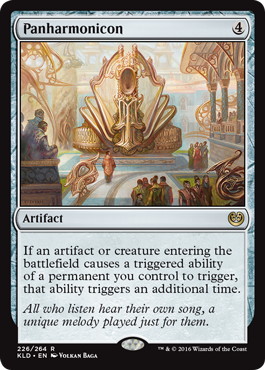 |  | 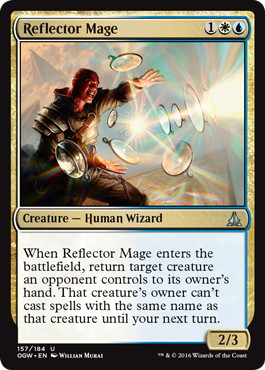 |
This deck is my first take on abusing 《Panharmonicon》. When evaluating the card, the main question should be “Not counting 《Spell Queller》’s, how many enter-the-battlefield triggers do I need after I cast this card to make sure it was worth it?”. One is absolutely not enough (I do not think there is a single ETB trigger in standard that would be worth investing four mana, even though some of the gearhulks come close). Two is kind-of-fine, but I would still not be overly excited, because you also need to take into account the fact that you probably lost a lot of tempo casting the card. Three is where you really begin to snowball. Basically, any combination of three ETB effects between 《Reflector Mage》, 《Skysovereign, Consul Flagship》, 《Drowner of Hope》 and 《Glint-Nest Crane》 is going to be worth a lot more than the four mana you had to invest in it.
Now that we got this part right, we also need to draw up a general game-plan. For me, the biggest issue with playing a 4-mana artifact that does nothing on its own is that you need to still have cards in your hand when you cast it; in other words, you will have to play 《Panharmonicon》 on turn 3 or 4 if you want it to actually matter. The obvious flaw is that it will instantly result in you falling behind on tempo, which is why the choice of being blue/white was super obvious: 《Reflector Mage》 is just a disgusting magic card once you start doubling its ETB effect, and it also happens to destroy any kind of tempo advantage your opponent might have in just one swing.
 | 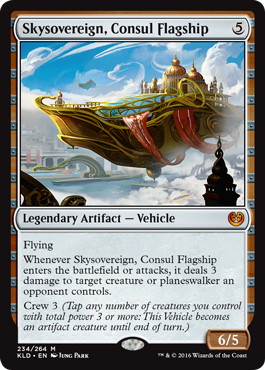 |
The rest of the deck is fairly self-explanatory, but still features a ton of nice synergies; I especially love how 《Glint-Nest Crane》 is both great at finding 《Panharmonicon》, and great at letting you snowball after you drew it. Apart from that, the deck plays out a lot like a blue-white tempo deck, where you attack them in the air with 《Eldrazi Skyspawner》 and 《Smuggler's Copter》 and hold the ground with your scions and 《Reflector Mage》. 《Angel of Invention》 is obviously quite sweet here, not only because it is yet another card that works well with Panharmonicon but also because you often have a lot of random critters chilling around. This lets you play a solid, if not spectacular, tempo game when you do not draw the namesake artifact. Also, 《Eldrazi Displacer》 shines in this build where it basically combos with every single creature you play, which makes it even easier to generate absurd amounts of value over the course of a long game.
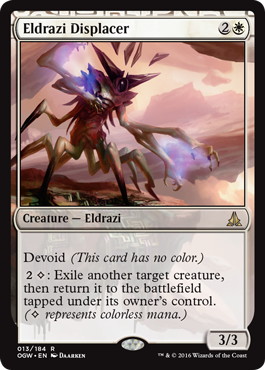 | 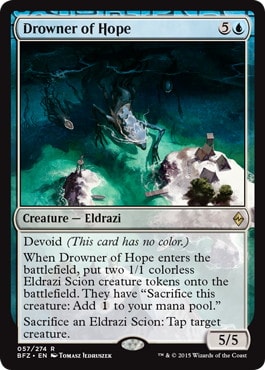 |
Finally, in case you did not notice, this deck features a powerful combo finish that I actually assembled quite often in testing: if you manage to control 《Panharmonicon》, 《Eldrazi Displacer》 and 《Drowner of Hope》, you can blink the drowner an infinite number of times, each iteration netting you one more scion token. In a vacuum, that lets you build infinite mana, infinite creatures, and infinite blinks.
From that point on, you can tap their whole board, bounce all of their creatures with a 《Reflector Mage》, or even do something really cool: if you also have a 《Glint-Nest Crane》, you can blink it until you find a 《Skysovereign, Consul Flagship》, play it and then keep blinking (remember that you also control an infinite number of scions to crew) until they have no creatures left.
At that point, I think we can all agree that the deck is sweet. It is still an experiment though, and there are a few issues that need working on, but this is definitely a solid start. Going further, I am less than happy playing 《Hedron Crawler》 in the face of a potential 《Liliana, the Last Hope》, and board sweepers should be a huge issue when we try to assemble creatures-based synergies. Still, I like the fact that we have a ton of synergies while playing almost only “good” cards that can hold their own in power-level wise. Trying other two-drops, and possibly 《Fairgrounds Warden》 as a “fifth” 《Reflector Mage》 for the aggro match-us are two things that sound interesting right now. You could also go nuts and splash a little bit of red, courtesy of 《Aether Hub》, to run 《Saheeli Rai》 as a way to hedge against removal while keeping a strong enter-the-battlefield them. Options, options…
Deck 2: RG EnergyEnergy counters are very close to being a sixth colour in Magic. As such, they are obviously an exciting novelty. It would be interesting to build a super energy-centric deck, but my initial idea was to try and see how well you could incorporate this new mechanic into one of the oldest decks in Magic: red/green beatdown.
|
4《Aether Hub》 2《Cinder Glade》 4《Game Trail》 4《Mountain》 10《Forest》 -Lands (24)- 4《Longtusk Cub》 4《Voltaic Brawler》 4《Servant of the Conduit》 4《Lathnu Hellion》 4《Tireless Tracker》 4《Bristling Hydra》 4《Verdurous Gearhulk》 -Creatures (28)- |
4《Incendiary Flow》 4《Harnessed Lightning》 -Spells (8)- |

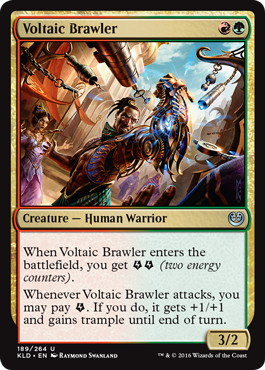 | 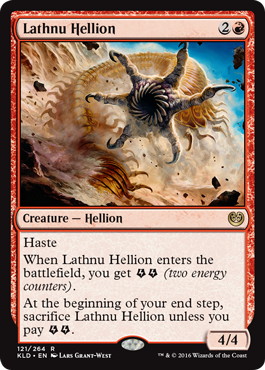 | 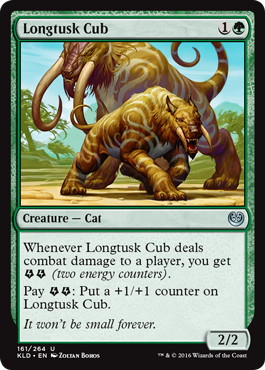 |
Here, we simply start by running the best aggressive creatures to try and close the game quickly: 《Voltaic Brawler》, and 《Lathnu Hellion》. Playing one into the other lets you swing for 8 on turn 3, which is just really fast and really easy to do. Since both of them work better with energy counters, I went a little bit further and tried incorporating more of those cards; 《Longtusk Cub》 has been an amazing overperformer so far, not really as a decent turn 2 play to push through, but mostly because as the game progresses and your opponent kills your early creatures, you are often left with a reasonable amount of unused energy to work with. Hence, if you draw the cub on turn 6 (when a 2-drop is not supposed to shine), you should be able to instantly make him a 4/4 or a 5/5. As such, you could think of him as the “aggressive 《Sylvan Advocate》”, and I do realize how high of a praise that is.
One thing worth noting here is that, in a way, both your removal can “go to the face”. 《Incendiary Flow》 does not need any explanation, of course, but 《Harnessed Lightning》 can actually play out just like a pump spell, where you play it on your own creature and decide not to spend the energy counter, so that you can boost your 《Longtusk Cub》 in combat or let that 《Lathnu Hellion》 attack one more time.
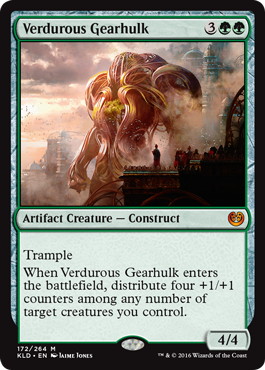 |  |  |
Lastly, the top curve is just high-impact cards that can easily win a match-up by themselves: 《Verdurous Gearhulk》 is a sick trump on a stalled board (putting 4 counters before attacking with a 《Voltaic Brawler》 is just really good), and 《Bristling Hydra》 acts a giant threat against control decks. Its ability to gain hexproof make it so hard to deal with, and when you add in the threat of you playing a 《Harnessed Lightning》 to get the necessary counters at instant speed, you just know that your opponent is in for a headache.
How good is the deck, you ask? Well, it is really good as a level 1 deck. I would imagine that people will be able to adapt at some point, but if you are looking for a powerful, proactive deck for week 1 standard, then you should absolutely give this a try.
Until next time,
Pierre Dagen
Cards found in the Article
Share in Twitter
Share in Facebook
 Pierre Dagen
Pierre Dagen
One of Europe’s most well-recognized players, whom at Pro Tour: Theros squared off against his “Les Bleus” teammate Jeremy Dezani in a Mono-Blue Devotion mirror match in the finals, a game to go down in magic history. Other notable achievements include a second PT top8 in Honolulu 2016, 3 GP Top 8’s, and 3rd place at the World Magic Cup 2015 as captain of the French team.

Related Articles
- 2016/09/08
- Standard Post Kaladesh Rotation
- Oliver Polak-Rottmann



